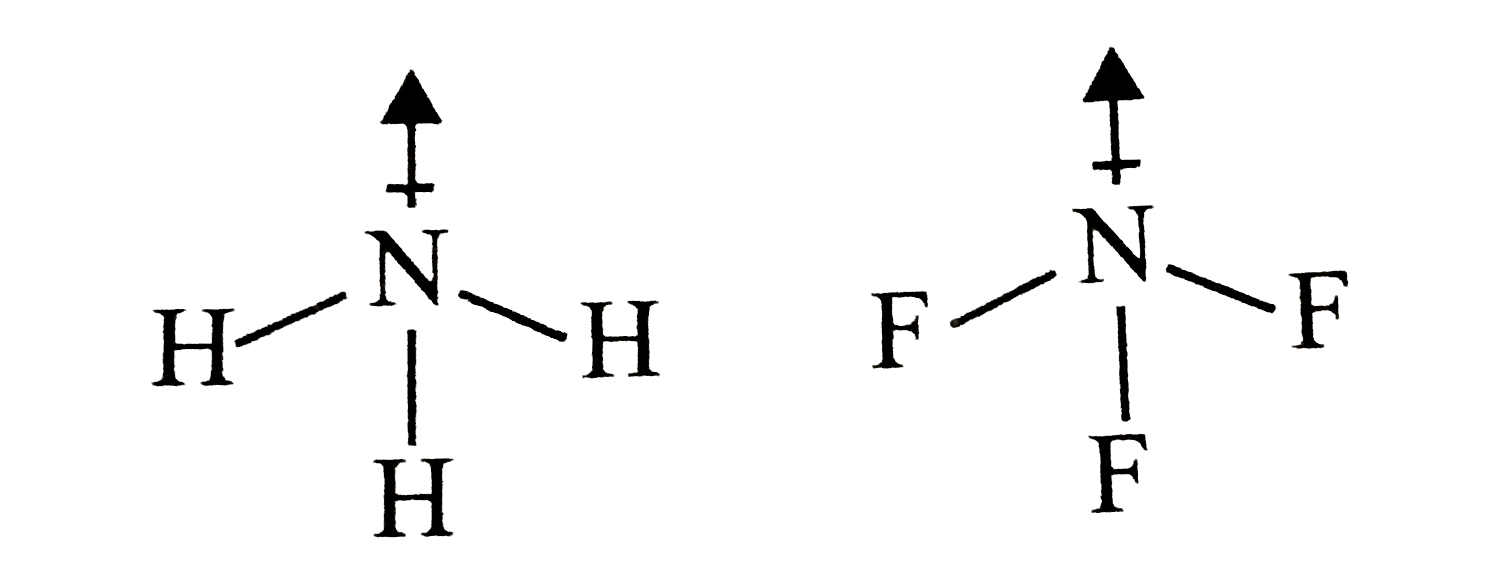A : NH3 is more polar than NF3 .
R : NF3 cannot be hydrolysed .
If both Assertion & Reason are true and the reason is the correct explanation of the assertion , then mark (1)
If both Assertion & Reason are true but the reason is not the correct explanation of the assertion , then mark (2)
If Assertion is true statement but Reason is false , then mark (3)
If both Assertion and Reason are false statements , then mark (4)
The correct Answer is:B
To analyze the given statements regarding the polarity of NH3 and NF3, we will break down the assertion and reason step by step.
Step 1: Understanding the Assertion
The assertion states that NH3 (ammonia) is more polar than NF3 (nitrogen trifluoride).
Explanation:
- Polarity is determined by the difference in electronegativity between the atoms in a molecule and the molecular geometry.
- In NH3, the nitrogen atom is bonded to three hydrogen atoms. The electronegativity of nitrogen is higher than that of hydrogen, creating a dipole moment directed towards nitrogen.
- In NF3, the nitrogen atom is bonded to three fluorine atoms. Fluorine is more electronegative than nitrogen, which means the dipole moments of the N-F bonds are directed towards fluorine.
Step 2: Analyzing the Dipole Moments
- In NH3, the dipole moments from the N-H bonds and the lone pair on nitrogen all point in the same direction, resulting in a significant net dipole moment.
- In NF3, the dipole moments from the N-F bonds point towards fluorine, while the lone pair on nitrogen points in the opposite direction. This results in a cancellation of some of the dipole moments, leading to a smaller net dipole moment.
Conclusion for Step 1:
Thus, NH3 is indeed more polar than NF3 due to the additive effect of the dipole moments in NH3 compared to the cancellation effect in NF3.
Step 3: Understanding the Reason
The reason states that NF3 cannot be hydrolyzed.
Explanation:
- Hydrolysis involves the reaction of a compound with water, which typically requires the ability of the compound to accept a lone pair of electrons from water.
- In the case of NF3, neither nitrogen nor fluorine has d-orbitals that can accommodate additional electron pairs. Therefore, NF3 cannot react with water to form hydrolyzed products.
Conclusion for Step 2:
While the reason is correct, it does not explain why NH3 is more polar than NF3. The inability of NF3 to hydrolyze is unrelated to its polarity.
Final Conclusion:
- Both the assertion and the reason are true.
- However, the reason is not the correct explanation for the assertion.
Answer:
The correct option is: Both assertion and reason are true, but the reason is not the correct explanation of the assertion.
---
The assertion states that NH3 (ammonia) is more polar than NF3 (nitrogen trifluoride).
- Polarity is determined by the difference in electronegativity between the atoms in a molecule and the molecular geometry.
- In NH3, the nitrogen atom is bonded to three hydrogen atoms. The electronegativity of nitrogen is higher than that of hydrogen, creating a dipole moment directed towards nitrogen.
- In NF3, the nitrogen atom is bonded to three fluorine atoms. Fluorine is more electronegative than nitrogen, which means the dipole moments of the N-F bonds are directed towards fluorine.
- In NH3, the dipole moments from the N-H bonds and the lone pair on nitrogen all point in the same direction, resulting in a significant net dipole moment.
- In NF3, the dipole moments from the N-F bonds point towards fluorine, while the lone pair on nitrogen points in the opposite direction. This results in a cancellation of some of the dipole moments, leading to a smaller net dipole moment.
Thus, NH3 is indeed more polar than NF3 due to the additive effect of the dipole moments in NH3 compared to the cancellation effect in NF3.
The reason states that NF3 cannot be hydrolyzed.
- Hydrolysis involves the reaction of a compound with water, which typically requires the ability of the compound to accept a lone pair of electrons from water.
- In the case of NF3, neither nitrogen nor fluorine has d-orbitals that can accommodate additional electron pairs. Therefore, NF3 cannot react with water to form hydrolyzed products.
While the reason is correct, it does not explain why NH3 is more polar than NF3. The inability of NF3 to hydrolyze is unrelated to its polarity.
- Both the assertion and the reason are true.
- However, the reason is not the correct explanation for the assertion.
The correct option is: Both assertion and reason are true, but the reason is not the correct explanation of the assertion.
Similar Questions
Knowledge Check
Assertion : Dipole moment of NH3 is greater than that of NF3.
Reason : Nitrogen is more electronegative than fluorine.Aboth assertion and reason are true and reason is the correct explanation of assertion.Bboth assertion and reason are true but reason in not the correct explanation of assertion.Cassertion is true but reason is false.Dboth assertion and reason are false.
(a) BF3andBrF3 molecule has different shapes. Expain.
(b). CCl4 cannot be hydrolysed but SiCl4 can be, why?
View SolutionAlthough F is more electronegative than H, the resultant dipole moment of NH3 is much more than that of NF3. It can be explained as

View SolutionPH3 is a weaker base than NH3
View SolutionDipole moment of NH3 is more than that of NF3, Explain.
View SolutionExplain why bond angle of NH3 is greater than NF3 while bond angle of PH3 is less than that of PF3,
View SolutionWhich has greater bond angle PF3orNF3 ?
View SolutionBond angle in NH3 is more than in PH3. Explain.
View Solution
